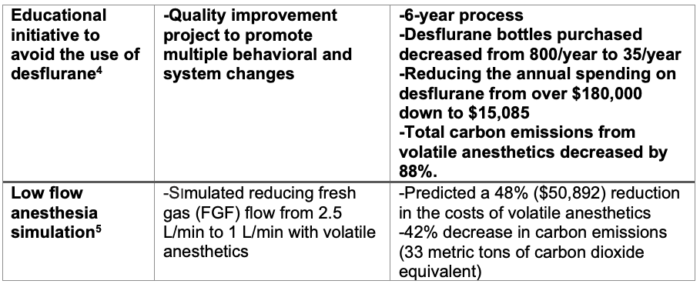Copy link
Economics of Sustainability in Anesthesia
Last updated: 09/12/2023
Key Points
- Sustainability practices can be economically beneficial for health care systems.
- Small sustainability practice changes can make a large economic impact.
- Sustainability projects that decrease the carbon footprint also decrease the costs of healthcare.
- Research and technology on the economics of sustainability are developing rapidly.
Sustainability Economic Basics
- Barriers include status quo practices, production pressure, infection control, and the culture of single-use items.
- Broad collaboration with multiple departments, administration, government, and industry is necessary to make impactful system changes.
Tools for Economic Sustainability
Life Cycle Assessment (LCA)
- LCA is designed to facilitate the quantification of a defined system’s material and energy inputs and outputs over its life cycle, as well as resulting contributions to regional- and global-scale resource depletion and environmental degradation.1
- Check out the OA LCA summary: Link
The Value of Sustainability in the Healthcare System
Inhalational Agents
• Anesthetic drugs may represent 5.7% of the total drug costs of the pharmacy.2
• Inhalational anesthetics may represent 20% of the drug expenses of an anesthesia department.2
• Central nitrous oxide delivery systems represent wasted revenue due at least 77% leakage to as high as 95% in storage, pipeline, valve, and patient-delivery leakage.3
• Examples of cost-saving results for anesthetic gases are listed in Table 1.

Table 1. Example of cost-saving results for anesthetic gases
Propofol and Drug Waste
- Wasted or discarded propofol accounts for 45% of the total perioperative pharmaceutical waste.6 Examples of cost-saving results for propofol are listed in Table 2.

Table 2. Examples of cost-saving results for propofol
Reusables
- The carbon emission net balance is dependent on the energy source mix.
- Water consumption is greater for reusable equipment. Examples of cost-saving results for reusables are listed in Table 3.

Table 3. Examples of cost-saving results for reusables
Wastestreaming
- Improper segregation can lead to resource misuse or inappropriate allocation, environmental pollution, and increased cost for the institution.
- Conscious sorting decreases hazardous waste incineration which is a high-cost waste stream component.
- Examples of cost-saving results for waste streaming efficiency are listed in Table 4.

Table 4. Examples of cost saving results for wastestreaming efficiency
Energy and Water
- Healthcare facilities consume close to 10% of the total energy used in US commercial buildings and spend more than $8 billion on energy every year.
- Examples of cost saving for energy and water efficiency are listed in Table 5.

Table 5. Examples of cost saving results for energy and water efficiency
Looking Forward
- Economic gain is a strong motivator regardless of belief in climate change urgency.
- Reprocessing is an economically sustainable tool. Reprocessing refers to a cleaning and resale process for single-use devices that are mechanically suitable for reuse.
- Eliminating leakage from central nitrous oxide delivery systems saves money.
- Technological advances from electronic record data analysis to new greenhouse gas capture and destruction industries should be utilized.
- Moving towards renewable energy sources should be considered instead of carbon-based fuels, such as solar and wind energy.
- A Leadership in Energy and Environmental Design certification should be initiated. The use of solar energy and other alternative noncarbon-based sources should be increased for hospitals.
- Environmental Social Governance should be incorporated into healthcare mission.
References
- Hellwer G, Mila I Canals L. Emerging approaches, challenges and opportunities in life cycle assessment. Science. 2014;344 (6188):1109-13. PubMed
- Odin I, Feiss P. Low flow and economic of inhalational anaesthesia. Best Pract Res Clin Anaesthesiol. 2005;19(3): 399-413. PubMed
- Seglenieks R, Wong A, Pearson F, et al. Discrepancy between procurement and clinical use of nitrous oxide: waste not, want not. Br J Anaesth. 2022; 128(1): e32-4. PubMed
- Wyssusek K, Chan KL, Eames G, et al. Greenhouse gas reduction in anaesthesia practice: a departmental environmental safety. BMJ Open Qual. 2022; 11(3): e001867. PubMed
- Edmonds A, Staumbaugh H, Pettey S, et al. Evidence-based project: cost savings and reduction in environmental release with low-flow anesthesia. AANA J. 2021; 89(1): 27-33. PubMed
- Mankes RF. Propofol wastage in anesthesia. Anesth Analg. 2012; 114(5):1091-2. PubMed
- Kicker JS, Hills HS, Matheson CK. Better pairing propofol volume with procedural needs: A propofol waste reduction quality improvement project. Hospital Pediatrics. 2018;8(10): 604-10. PubMed
- Chambers E, Fitzhenry J, Lincul D. Propofol waste reduction in the operating room. AANA J. 2022;90(6):411-6. PubMed
- Sherman JD, Hopf HW. Balancing infection control and environmental protection as a matter of patient safety. The case of laryngoscope handles. Anesth Analg. 2018;127(2): 576-9. PubMed
- Wormer BA, Augenstein VA, Carpenter CL, et al. The green operating room: Simple changes to reduce cost and our carbon footprint. Am Surg. 2013;79(7): 666-71. PubMed
- Fraifled A, Rice AN, Stamper MJ, et al. Intraoperative waste segregation initiative among anesthesia personnel to contain disposal costs. Waste Manag. 2021; 122; 124-31. PubMed
Other References
Copyright Information

This work is licensed under a Creative Commons Attribution-NonCommercial-NoDerivatives 4.0 International License.